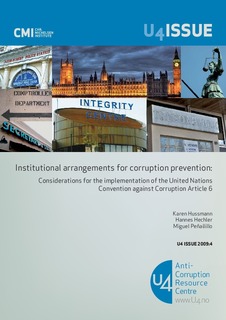Institutional arrangements for corruption prevention: Considerations for the implementation of the United Nations convention against corruption article 6
Research report
Permanent lenke
http://hdl.handle.net/11250/2474602Utgivelsesdato
2009-04-22Metadata
Vis full innførselSamlinger
- Publications [1488]
Originalversjon
Bergen: Chr. Michelsen Institute (U4 Issue 2009:4) 26 p.Sammendrag
What kind of institutions does a state need to have in place to effectively prevent corruption? What does it mean, when article 6 of the UN Convention against Corruption (UNCAC) requires states to ensure the existence of a body or bodies to prevent corruption? It has been argued that this calls for specialised preventive anti‑corruption agencies, preferably one. While this might be one of several options, this U4 Issue Paper argues differently. As the UNCAC requires such bodies to be in place not only for coordinating and supervising preventive anti‑corruption policies, but also for their implementation, it is unavoidable that this implies the involvement of a variety of institutions. By unravelling the functions prescribed in article 6 from a public policy perspective, this paper also sets into perspective what is meant by granting the body or bodies the "necessary independence" to enable them to carry out its or their functions effectively and without undue influence. Obviously, this "necessary independence" will look differently depending on whether one has to coordinate, supervise, or implement an anti‑corruption policy, not to mention increasing and disseminating knowledge on corruption prevention, as also stipulated in article 6.
Utgiver
Chr. Michelsen InstituteSerie
U4 Issue 2009:4Beslektede innførsler
Viser innførsler beslektet ved tittel, forfatter og emneord.
-
Corruption, corruption prevention, and good governance
Amundsen, Inge (Others, 2012-11-14)A one-day programme on Good Governance and Corruption Prevention in the Petroleum Sector , in Elmina, Ghana. Arranged by Petrad for Norad's " Oil for Development " programme, as a part of a two-week training programme ... -
Mapping evidence gaps in anti-corruption: Assessing the state of the operationally relevant evidence on donors' actions and approaches to reducing corruption
Johnsøn, Jesper; Taxell, Nils; Zaum, Dominik (U4 Issue 2012:7, Research report, 2012-11-15)This paper charts the current evidence on effectiveness of different anti-corruption reforms, and identifies significant evidence gaps. Despite a substantial amount of literature on corruption, this review found very few ... -
Trading in corruption: Evidence and mitigation measures for corruption in the trading of oil and minerals
Longchamp, Olivier; Perrot, Nathalie (U4 Issue 2017:6, Research report, 2017-06-01)Between 2011 and 2013, sales of government oil from the ten biggest producers in sub-Saharan Africa accounted for 56% of these countries’ total public revenues. Despite their importance, however, such sales have received ...
